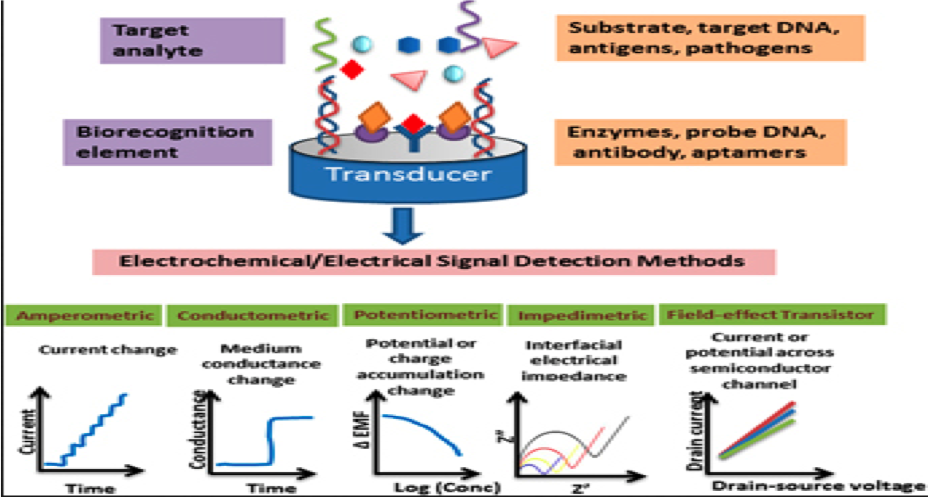3D printed biosensor for food safety point of care: state of art and potentiality for a trough-out food pathogen detection.
Abstract
While conventional techniques such as mass spectrometry represent outdated methodologies used for pathogen detection in food safety management, they have been inefficient for point of care application due to high costs, time-consumption and lots of labor needed. The inefficiencies associated with the customary detection techniques can be addressed through 3D printed biosensor which represents a latest technology for food safety Point of Care. Food safety concerns represent momentous meaning in food processing and distribution to diverse locations domestically and internationally. Pathogens that cause food contamination include viruses, bacteria, and chemicals such as adulterants, metals, and pesticides which can lead to severe and wide-spread financial losses and life afflictions.
Health complications, organ damage, and diseases including cancer represent some of the damages caused by food risks to the human body and may entail severe to persistent effects within various time periods. Food-induced health risks can cause outbreaks domestically or spread into both emerging and developed economies which makes these risks highly unpredictable. Therefore, an understanding of foodborne pathogens to appropriately handle and prepare food represents a vital factor to ensure food quality and the conservation of societal well-being. Comprehending the dynamics around foodborne pathogens presents a specific significance in the food value chain activities like manufacture, packaging and distribution. This review highlights the 3D printed biosensor for trough out pathogen detection systems, and their integration and development with advanced modern bio-sensing technology, with the main aim to ensure food quality and safety. Besides, this article highlights the newest trends in integrated 3-D printed bio sensing applications to enhance food safety, particularly POC diagnostics.
Contents
3D Biosensors in POC Detection of Foodborne Pathogens. 9
The bio receptor immobilization and 3D biosensor design. 10
Biosensors under Transducer Categories. 11
3D Electrochemical biosensor 14
Effectiveness of 3D sensors Detection methodologies for pathogens and toxins. 19
Current Challenges and Future Trends. 20
Introduction
There are many crucial food safety issues but the most essential are those presented by foodborne pathogenic bacteria and virus. There are many diagnostics methods that are developed but they are time consume and not particularly effective for the food varieties currently being developed. As this problem keeps advancing, experts have been developing some point-of-need diagnostic 3D printed biosensors that make use advanced technologies such as microfluids and nanomaterials. These biosensors are highly sensitive and specific making the pathogen detection process swift and reducing the costs involved. These 3D printed biosensors are analytical devices that are able to quickly and directly detect pathogens and toxins from the food substance even without pretreatment procedures.
Bio sensing represents a technology that facilitates the conversion of chemical, biological, and biochemical reaction into an input signal discovered by a bio receptor and converted and augmented through transduction into a detectable and computable output signal with indispensable waveform traits. This process is made possible by the inbuilt 3D printed physical or chemical transducers and biological detection materials. The output signal is then revealed, saved for analysis to inference valuable diagnostic information. Experts are regularly coming up with various types of 3D printed biosensors to develop the speed and adeptness of the food pathogen detection process. The advancement to 3D printed biosensors presents researchers with ample study scopes on the potentiality for direct food pathogen detection.
The efforts towards food safety improvement signifies a multidimensional challenge and greatly relies on the recognition and quarantine of pathogen infested food substance at different phases of the food value chain. Fundamentally, an understanding of pathogen-food interaction and pathogen life-cycle is needed to enhance the detection and quarantine of the pathogens in food materials. 3D biosensing technologies represent new emergent technologies that facilitate easy detection of pathogen in food substance to enhance food safety. According to various researchers, these emergent technologies enhance the potentiality for direct detection of pathogens in food stuff eliminating the conventional pre-treatment procedures.
There has been an international wake on issues relating to food safety since they have great effect on wellbeing of individuals and their lives. Human safety has to be considered by detecting foodborne pathogens which may contaminate food and its products making it unsafe for consumption. Most of the food pathogens are introduced into the food from the environment and can easily go undetected if critical detection measures are not put in place. The most predominant food pathogens are the bacterial pathogens but in the recent past the foodborne viruses are gaining attention (16,17). There has been several small-scale outbreaks and events of foodborne viral contamination across the world making it a field that requires utmost scrutiny to avoid spreading. Such problems in the field have led advancement in the methods applied in the pathogen detection. It is for such reasons that experts are developing new 3D printed biosensors that can detect the advanced and relatively new pathogens and provide results in real time.
In the recent years, the world has been faced by so many food safety issues that required advanced pathogen detection measures in food substances. In most cases fresh produce dominate the topic where foodborne diseases have been witnessed in European and North American countries. In the United States alone, there has been cases of two major pathogens namely; Salmonella which caused 18% of the diseases and Norovirus which caused 59% of foodborne diseases. The two have also been the most dominant pathogens in European countries with Salmonella taking 20% and its counterpart taking 53%. In Canada, it is a different case since Salmonella is the dominant pathogen covering 50% of the diseases. Instead of Norovirus, Canada has Hepatitis A virus as the second pathogen although it is only responsible for 0.1%.
The reason for these outcomes may be because the major fresh produce pathogens in Canada are bacterial, and can be detected through the old detection methods. The viral pathogens in Canada include the Porcine Enteric Calicivirus and Hepatitis E Virus, but they are all farm-level pathogens. They are predominantly present in finisher pigs and therefore infect humans through exposure to pork. Studies on the 3D biosensors express optimism on the potentiality for direct pathogen detection due to advancements in sensor technology. Therefore, this study provides insight on the various quick food pathogen detection methods enabled by use of 3D printed biosensors. These advanced 3D printed biosensors reduce the cost, analysis time and do not require many specialized personnel, unlike the previously used systems which applied molecular, immunological, and cultural pathogen detection methods 23.
Objective of the Study
While numerous studies have researched on POC devices there exist some problems that ought to be solved in relation to complete implementation of the technology into everyday applications. In an attempt to address these challenging aspects, several studies try to evaluate measures to achieve advances in sensitivity, multi-functionality, multiplexing and quantification in the assessment of POC food pathogen detection. For example, there exist several studies that explore signal amplification methods with regard to their integration into paper- and chip-based systems to improve sensitivity during analysis using approaches like silver enhancement and dual labeling. Several smartphones were coupled with system like readers to realize quantifiable data during food pathogen and harmful chemical detection without pretreatment procedures.
Additionally, fabrication of POC systems with the capacity to execute multiplexed detection functionalities represents a well-studied concept by numerous researchers. Most researchers highlight that POC fabrication would considerably lessen cost and assay time thus augmenting assay throughput 6. In recent times, several scholars and scientists have introduced the concept of 3D biosensor systems that integrate several crucial processing phases into a solitary device for direct pathogen detection. The initiation of such technological advancements has oddly improved the efficiency of POC systems to realize more operational approaches for direct enhanced food pathogen detection and food safety measures.
3D printing
| Three-dimensional (3D) printing | Method | Resources(examples) |
| Fused deposition modelling(FDM) | Extrusion | Filament, polymers |
| Droplet deposition/layering | Inkjet | Powder+liquid binder, polymer, ceramic, metallic |
| Direct metal laser sintering (DLMS) | Laser beam | Powder, metallic |
| Selective laser sintering(SLS) | UV Light | Powder, polymer,
Metallic, ceramic |
| Stereolithography (SLA) | UV Light | Liquid, Photopolymer |
(hospitalpharmacyeurope.com, 2020)
The first 3D printer was developed in the 1980’s and it was based on the additive method with photo hardening thermoset polymer. Later 3D printers based on stereo lithography (STL) were developed and these were equipped with curing of the photopolymers with UV light lasers. Recently, this technology has been classified into three as follows. Vat polymerization, 12material extrusion and material jetting. Vat polymerization is further subdivided into Continuous Digital Light Processing (CDLP), Stereo lithography (STL) and Digital Light Processing (DLP). There were classified depending on the method by which they are cured STL with laser, DLP with a projector DLP with LED and oxygen together. Fused deposition modelling was used not only to print functional prototypes but also concept models. FDM deals with production-grade thermoplastics (6,7). Lastly is Material jetting, which is classified depending upon the curing method and the polymer used. This subclass includes. Material jetting where curing is with UV light and the end product is plastic. Further depending on the size of the drops they are classified as nanoparticle jetting where curing is done with heat and the material used is metal.
Methodology
The study utilized data synthesis, through a thematic evaluation technique where several features ought to be adopted from the review of literature. The processes of synthesizing and studying qualitative study remains hugely vague. Though, the study utilizes an evaluation of the original published works on 3D printing techniques and bio sensor technology as a conventional research technique for methodical evaluation of studies. Thematic analysis should be employed to validate 3D printing concepts and techniques.
Different research papers were assessed for applicability from the abstract and title. The approach focused on details of 3D printing, Food Pathogen detection, Bio sensor technology for food pathogen detection, qualitative approaches, and experiential results. In cases where there exist inadequate details in the abstract the study ought to assess full papers to retrieve crucial data. The quality of study, papers need to get a score out of 7 for its methodological precision through the inclusion of a definite framework and literature review, clear aims and objectives, thorough context description to enable the researcher to relate the conclusions to other findings, and a generate a clear depiction of food pathogen detection.
Various 3D printing techniques in food safety.
3D printed biomimetic biosensors presented for food safety do detect pathogens in low quantities, they also do monitor their internalization and they find out whether there will be a biofilm formation. Capacitive or impedance measurements are used by these sensors to detect pathogens and they utilize 3-D traits that allow bacteria to fill the space testing space created between electrodes and substrate. In comparison to a two-dimensional planar sensor, interdigitated sensors are assessed through finite examination while the sensors contain a parallel-platter sensor device and belated electrodes. It is through the simulation results, we are able to know that improved sensitivity in sensor biofilms and microorganisms are achieved by all 3D sensors than the 2D sensors under similar circumstances.
3D Biosensors in POC Detection of Foodborne Pathogens

Science Direct, 2020)
Biosensor categorization involves its two key technologies namely bio receptors or transducers. During bio-sensor categorization with regards to bio receptors, there exist 6 key biosensor categories including: nucleic acid, antigen, biomimetic, phage, enzyme, and cell27. However the most known bio receptors include nucleic acid, antigen, and enzyme where the latter represents the most popularly used as an element for bio recognition and performs several functionalities beyond its generally prescribed bio receptor function. Using transducer categorization, biosensors comprise Mass-based, optical and electrochemical categories.
In 3D parallel-plate and interdigitated sensors display a sixteen percent and a thirty percent higher sensitivity in detecting microorganisms and in the detection of biofilm there are percentages of forty four and forty eight sensitivities. Studies highlight that pathogen internalization monitoring in real time requires a biomimetic device with a stack of electrodes is presented (19, 20, 24, 28). Multiple bio-sensor layering resembles an authentic application that tracks the infiltration of bacteria and viruses into the detection area. This work enables us to comprehend the time a microorganism takes to enter a food substance and reveals ecological parameters like changes in temperature or the existence of nutrients and sanitizers and influence their behavior to provide useful data to enhance food safety and decontamination measures.
The bio receptor immobilization and 3D biosensor design.
Sensor characteristics are immobilized through a variety of aspects. This is done to ensure that all the features can meet the demands that are used in the inclination of paramagnetic and biocompatible properties. It is important to note that support for materials and antibody immobilization is an aspect that is determined based on the microbial analysis that is done at a given time. Noteworthy, scholars in this field ought to expound on the understanding that the use of nanotubes and the electric conductance of biosensors do not limit the surface materials for testing and reflects on the transducing techniques within a given time 7.
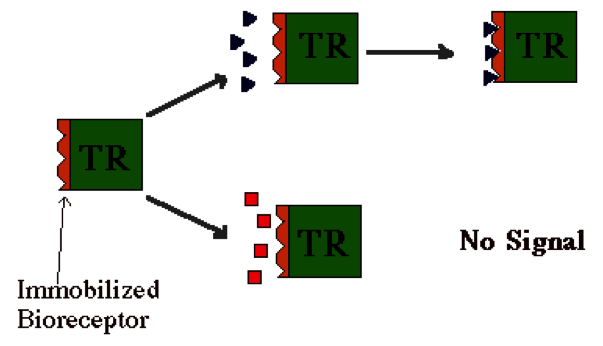
(Gatewaycoalition.org, 2020)
Biosensors under Transducer Categories
A biosensor represents a device for the detection and analysis of the biomolecules in the food substances. The sensor usually has three components including; recognition, transduction, and signal processor. The recognition component is the first to be applied to determine the target analytes, followed by the transduction component which transforms the recognized analytes into measurable signals which are lastly processed by the detector 3. Classification of these biosensors on the basis of transducer can be categorized as, electrochemical, mass-based and optical biosensor.
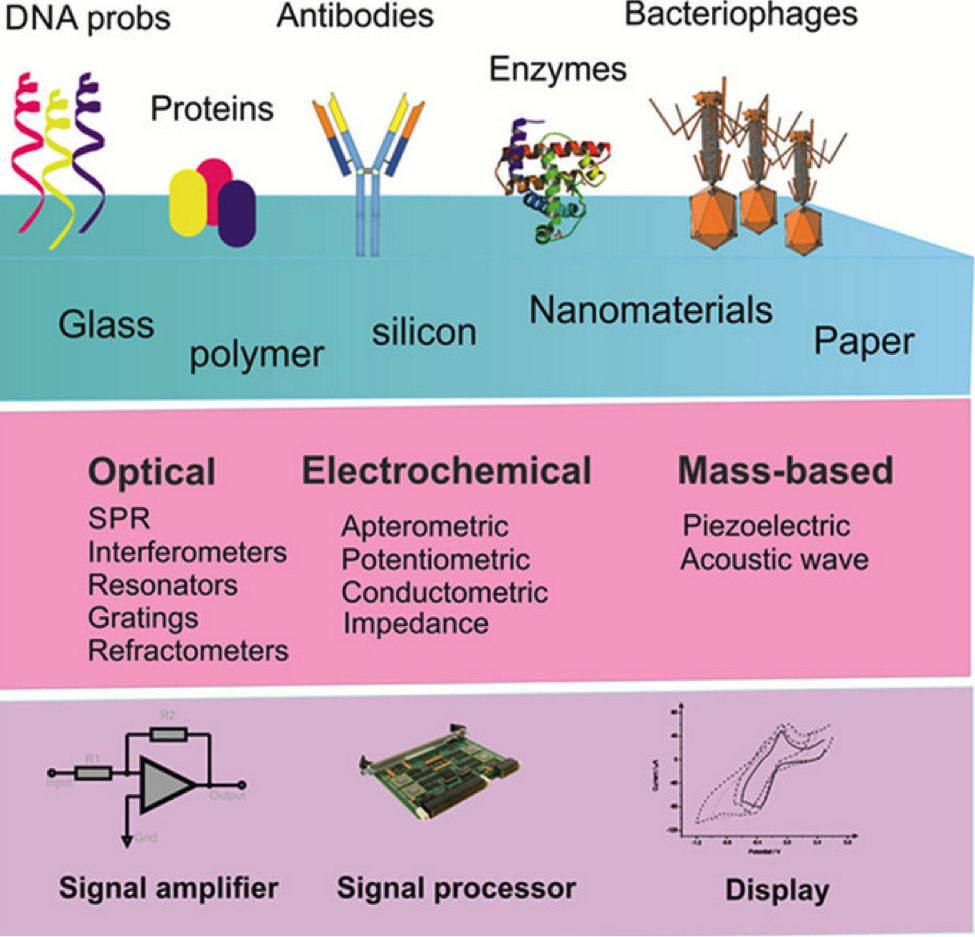
3D Optical biosensor.
The optical biosensor begins the pathogen detection process by performing a chemical reaction of the analyte and the indicator which produce an optical signal. This beginning stage is important because it establishes the optical measurement’s wavelengths and improves its selectivity, stability, and sensitivity. Optical biosensors depend on measurement of light produced by a chemical reaction (3,4). Basically optical biosensors are comprised of a variety of optical techniques like fluorescence, absorption, luminescence and surface Plasmon resonance (SPR).
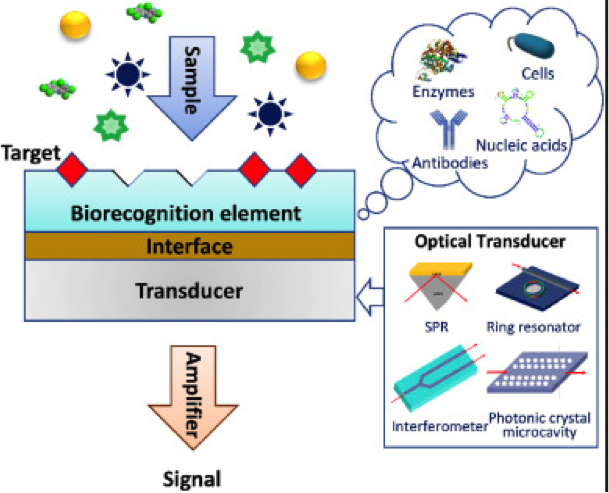
The SPR transducer-based biosensor represents one of the most progressive label free and real time sensors which comprises a SPR measure refractive catalog on metal surface containing an extremely shrill layer of nanomaterial. Its main function is to detect the similarity index between interactions involving, protein / DNA, ligand / receptor and antigen /antibody.
Other interactions like substrate-enzyme and harmonizing DNA-DNA induce actions 21. A combination of immunosensors, aptamer and hybridization techniques with the SPR biosensors can enhance their application on virus detection. There exist a possibility for 3D printed sensor to reduce the analysis time with the application real‐time monitoring of biomolecular exchanges and viable time miniaturization through optical fibers and waveform structures that utilize light rather than old-style prism in analysis.
3D Electrochemical biosensor
Biosensors under electrochemical categories comprise of; potentiometric, amperometric and conduct metric where they measure the possibility of the biosensor to infer sensor signals through a reference electrode. Also there categories quantify the current present in the course of reducing electroactive reactants. Finally they analyze and report on the variation in conductance resulting from biochemical responses.
(Terse-Thakoor, Badhulika, & Mulchandani, (2017).
The advanced 3D electrochemical biosensors provide high response speeds, sensitivity, and are practical 4. With these features and their integrated lab-on-chip (LOCs), they can be used at the point of care and directly to the food substance. The results are therefore obtained much faster and the food that is found to contain the harmful pathogens is disposed of preventing the harm it would cause if not detected. For this paper, the electrochemical biosensor concept is defined using electrochemical methods that are applied in the transduction systems of foodborne pathogen biosensors.
Sandwich electrochemical sensors have been used to determine a number of variants and the influence of carbon nanotubes. The nanotubes are based on the rapid biochemical characterization of analysis that is done on pure cultures and the components of the enzymes that take place within a given time. There exist a possibility of direct pathogen detection through Magnetoelastic (ME) bio sensors which comprise of amorphous ferromagnetic alloys. Once triggered by an exterior time‐fluctuating magnetic pitch, the constituents display a ME reverberation that can be identified through a non-contacting spontaneous coil (16, 18, 29). After a micro-organism comes in contact with the amalgam sensor platform, the extra mass leads to a reverberation frequency change while the pick-up coil tenuously detects the signal. Consequently, ME sensors represent wireless strategies that offer the possibility of direct pathogen detection for in‐field observations. The ME bio sensors can perform food pathogen detection on the surface of fresh produce without any sample preparation procedures.
The electrical biosensors in salmonella have been used in a number of analysis for fast food products today. The results have included biosensor analytical applications. The electrical biosensors determine a variety of continued basis used for the creation of Nano tubs that are conjugated with the materials that have been sued to enhance the creation of biosensors and the given transducing techniques 3. A number of the creative aspects must be determined in terms of its ability to incorporate the sensor needs and act on the sensor information and the way the information kits used in the determination of the sensor analysis. It is important to understand that a number of the sensor in formation result.
3D Mass-Based Biosensor.
The other name for the mass-based biosensor is the gravimetric biosensor since it applies the response to mass change principle. These biosensors use either the QCM (Quartz Crystal Microbalance) or SAW (Surface Acoustic Wave) devices. QCM is a form of resonating crystals and it shortens the analysis time, produces label less measurements, lowers the cost, and it is easy to use. These features have made them the best form of biosensor for rapidly detecting toxins and pathogens. A typical QCM biosensor is made up of two metallic electrodes and an AT-cut Quartz crystal in between them (1,4,24,15). The mass change on the surface of the crystal determines the QCM’s resonant frequency. The micro-organisms are detected by directly combining the QCM biosensor with the food substance being tested. The SAW biosensor is used in detection of acoustic waves from the piezo electric crystal’s surface after the mass is loaded. The SAW detects the acoustic waves through the interdigital transducer (IDT). The IDT confines the acoustic energy on the surface of the crystal regardless of the substrate.
According to studies mass based nanoelectromechanical systems represent key enabling factors for new biosensor applications as a result of their amazing sensitivity in regards to changes in mass (2,4,14,15). According to research mass-based mechanical biosensors, encompass two major metrics. Firstly, it contains a metric namely smallest detectable mass, representing its relative mass sensitivity. Using the oscillation incidence of a mechanical systems resonator the 3-D biosensor functions through sensitivity as an identifier for its absolute mass. For food pathogen detection the resonance frequency ought to be measured with the aim of detecting changes in mass 28. To detect small mass changes entails operating a light resonator at a high-quality cause. This facilitates the possibility to skip food sample pretreatment before pathogen detection with the development of techniques that provide historic data regarding the most common foodborne pathogens in food samples that do not require enrichment 9. The data can be used to prompt food pretreatment before pathogen detection based on similar actions on similar food samples. Also, detection methods based on non-cultural approaches for effectiveness in separation, absorption, and pathogen cleansing which significantly lessens the overall analysis.
Secondly, the smallest detectable mass over the sensing surface area of the device represents sensitivity regarded as mass-per-area. It is essential in the contrast of concentration sensitivity.

Immersing a biosensor in a solution for pathogen detection requires a definite concentration where total mass of the biomolecules on the sensing device ought to be proportional to the sensor surface area at a given time in rectilinear area. With a low concentration mechanical bio sensing there exist a need for big sensor surface area for particles to impasse for quantification of minimum detectable mass. For solution concentration detection, the mass-per-area sensitivity is very essential. Low concentration bio sensing through mechanical resonators requires large device surface area and low detectable mass for molecules to bind. According to studies, the mechanical biosensors achieve high mass-per-area sensitivity during food pathogen detection. High mass-per-area sensitivity of these sensors at low concentrations enables bio-molecule detection enhancing the potentiality of direct food pathogen detection.
Biosensors in Detection of Foodborne Viruses and Bacteria
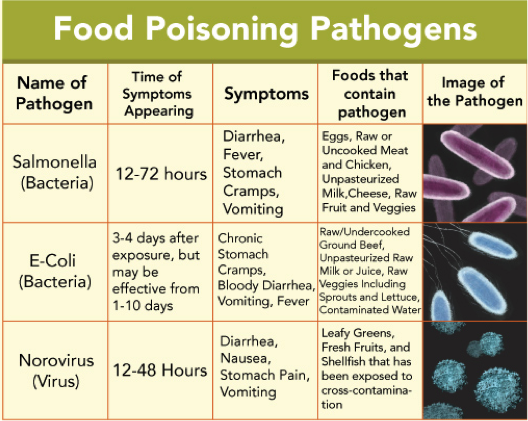
(Daily Titan, 2020)
A biosensor represents a device that is capable of converting a biological phenomenon into an input signal detected through a bio receptor and transformed then augmented through transducing techniques into a measurable and recognizable feedback signal with waveguide structures that can enhance trough out food pathogen detection (10, 11, 12, 13) . To bring about useful diagnostic information, the output signal ought to be displayed, stored and analyzed to facilitate sound conclusions. In detection of food borne viruses, biosensors such as norovirus, rotavirus and hepatitis have been applied with minimal preparation procedures providing a possibility for a reduction in detection time which is vital for foodborne infection control4. Consequently, the contaminated food products and epidemic sources can be recognized rapidly to avert further spread of the infection. Electrochemical biosensors have the most advantage over other sensors because of their fast speed, high quantification and sensitivity. Noteworthy, electrochemical biosensors encompass the POC purpose because of their features of miniaturization and data logging. Targeting is basic and low-cost POC detection entails the use of label free biosensors help to achieve the feat.
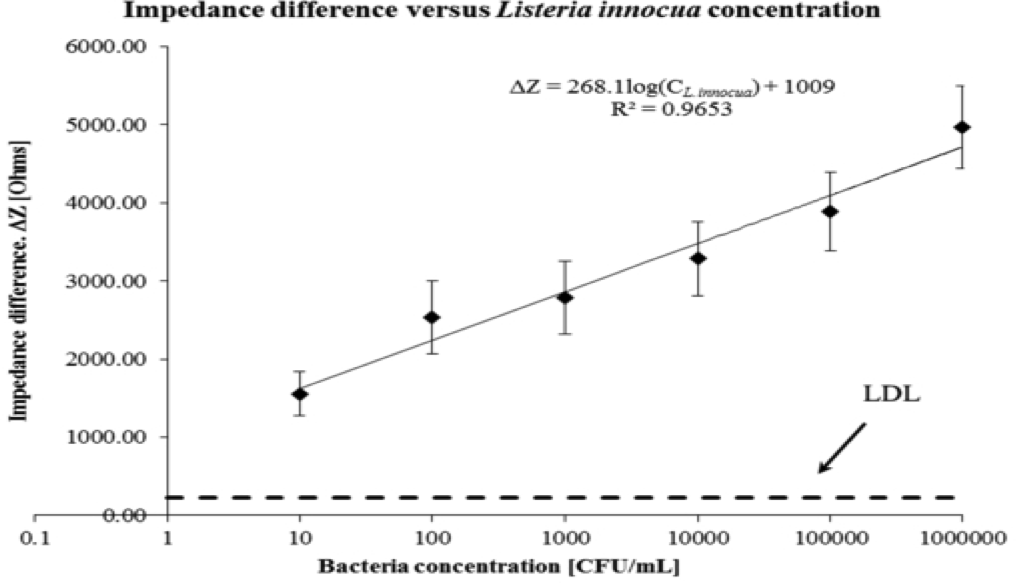
Biosensors in Detection of Foodborne bacteria
An estimation of 600 million foodborne illnesses with 420,000 deaths happen globally, a study done in 2010 by Foodborne Disease Burden Epidemiology Reference Group under The World Health Organization and the main causes of these illnesses are the pathogenic bacteria which such as the Escherichia coli and salmonella. Methods for pathogen detection are based on plate counting which need enrichment and long analysis of the sample 12.
For bacterial-pathogen detection, biosensors are based on DNA and immune recognition2. Recognition agents such as synthetic antimicrobial peptides enable detection and quantification of four bacterial strains like the Escherichia coli, Staphylococcus aureus, staphylococcus epidermidisa and Pseudomonas auregisona. Colorimetric biosensors strips fitted with peptides detect Listeria monocytogenes in meat and milk (11, 12, 22)
Effectiveness of 3D sensors Detection methodologies for pathogens and toxins.
During 3D sensor detection methodologies, toxins and pathogens are intercepted at the array based revolver that then sends the results for scrutiny in different directions during the analysis to enhance effectiveness. In a measure of the results and how the determination goes, focus is usually put on the simultaneous detection of the elements subject to analyses and how the diverse scope of the analyses are made to identify element reactions within a particular analytical technique. The techniques enhance effectiveness while defining aspects of molecular detection platforms which depend on cases of volume precision, sensitivity and preparation of the quarantines. This definition is essentials in the determination of the detection platforms that are then used in the separation, filtration and creation of commercial levels within a given aspect of the molecular filtration during the detection for toxins and pathogens 24. This aspect then becomes the chief determinant of the entire aspect of effectiveness in the 3D sensor detection methodologies.
Additionally, the analyses of the biosensors at the end of the detection methodologies shows limitless analysis that explore the results of the separation, filtration and basic analysis of the end results to enhance effectiveness. It is important to understand that the basis of the colometric detection and the transportation and amplification of the further lateral flow zones. It is an analysis that comes into effect the signal amplification and volume accuracy that depends on food contamination in the commercial levels to control signal amplification during the detection process.
The detection methodologies base their results on the amplification aspects where the pathogens that are reported and seen in the diverse amplification aspects become laterally absorbed in the resultant accommodation of the techniques that are done and made in this experiment30. A paper sample to answer detection system is undergoing further tests that will allow massive integration of the systems in order to allow them have the integrated results in one system20.Further, it will help in the accommodation of the many biases that might occur in an independent sensing technique that has been used today.
Current Challenges and Future Trends.
There is an advancement of POC technologies in the detection of foodborne bacteria than in the detection of foodborne virus. Viruses are not capable of replicating in host free environments. Bacteria detecting platforms ought to be comprehensively improved, because there exist a small number of viruses, for substantive virus particle detection. Composition of cell surface proteins cannot be compared to the hemagglutinin and neuraminidase conformations in viruses. In the United States the test for food pathogens need be carried out using the 100mL of food solutions or solid food samples. So it is required that the devices to be made to meet these requirements on real-time or on-site. There exist only a few f viral particles in in food due to the complex sample matrix presented in the context. Separation, purification and concentration are essential in virus detection. There are four commonly viral concentrations techniques. These include: monolithic adsorption, organic flocculation with skim milk, glass wool filtration and polyethylene glycol.
Conclusion.
Consumer and industry awareness represents the most basic step towards food safety improvement. Few principal daily activities can enhance food safety. Notwithstanding traditional approaches that often represent fundamental food safety influencing elements due to their consistency, low cost, specificity, and simplicity; however they consume a lot of time and entails increased work. There exists numerous developments with regards to detection and recognition of foodborne pathogens over the years to counter the confines of the traditional approaches. Among the recent developments in foodborne pathogen detection, nucleic-based methods, immunology-based methods and biosensors represents the major tools utilized around the world. The benefits of each method depends on the target pathogen and the kind of food. However, these methods require slight improvements to inhibit their major disadvantages to enable practical implementation in the food industry. In contrast to conventional microbiological approaches, rapid commercial technologies present more sensitivity in pathogen detection, while offering more time efficiency, minimal labour utilization, and decreased human error. The high cost and a trained technical staff requirement makes the new technological detection methods impractical for daily use within the food industry. Today, there exist regular release of new detection methods; however their recognition by the industry relies on several factors such as cost, speed, initial investment, technical support, and ease use. Certainly, progressive researches have congregated to enhance the development of new modest, sensitive, precise, and time-saving technologies of foodborne pathogens detection that would offer the most practicality in food industry.
Work Cited
- An overview of foodborne pathogen detection: In the perspective of biosensors – Science Retrieved January 06, 2020, from https://www.sciencedirect.co m/science/article/abs/pii/S07 349750090021
- Arlett, J. L., Myers, E. B. & Roukes, L. Comparative advantages of mechanical biosensors. Nat. Nanotechnol. 6, 203–215 (2011).
- Banerjee, R.; Jaiswal, A. Recent advances in nanoparticle- based lateral flow immunoassay as a point-of- care Bioelectron.2019, 140, 111333. [CrossRef] [PubMed]
- Barrett, Terence W., and John F. “Optical 3-d signature device for detecting chemical agents.” U.S. Patent No. 4,650,329. 17 Mar. 1987.
- Chen, Y., Liu, J., Yang, Z., Wilkinson, J. S., & Zhou, X. (2019). Optical biosensors based on refractometric sensing schemes: A review. Biosensors and Bioelectronics,
- Consuming Contaminated Food. (2020) CSUF students share their experiences with food poisoning – Daily Titan. Retrieved January 06, 2020, from https://dailytitan.com/2018/0 5/csuf-students-share- experiences-food-poisoning/
- Craighead, H. G. Nanoelectromechanical Science 290, 1532– 1535 (2000).
- Creating A Platform. (2020) Printing technologies and tailored dosing -Hospital Pharmacy Retrieved January 06, 2020, from https://hospitalpharmacyeuro pe.com/news/editors- pick/printing-technologies- and- tailored-dosing/
- Domon, B. & Aebersold, R. Mass spectrometry and protein Science 312, 212– 217 (2006).
- Fernández-la-Villa, A.; Pozo-Ayuso, F.;Castaño Álvarez,M.Micr ofluidics and electrochemistry: An emerging flow based immunobiosensors for detection of food contaminants. Biosens.Bioelectron.2016, 86, 235–246. [CrossRef]
- Gang, A., Gabernet, G., Renner, L. , Baraban, L., & Cuniberti, G. (2015). A simple two- step silane-based (bio-) receptor molecule immobilization without additional binding site passivation. RSC Advances, 5(45), 35631- 35634.
- Impedance biosensor for the rapid detection of Listeria spp. based on aptamer functionalized Pt- interdigitated microelectrodes Retrieved January 06, 2020, from https://www.spiedigitallibrar y.org/conference-proceedings-of- spie/9863/1/Impedance-biosensor-for-the-rapid-detection-of-Listeria-spp- based/10.1117/12.2223443.short?SSO=1&tab=ArticleLinkFigureTable
- Ishii, S.; Kitamura, G.; Segawa, T.; Kobayashi, A.; Miura, T.; Sano, D.; Okabe, S. Microfluidic quantitative Ishii, S.; Segawa, T.; Okabe, Simultaneous quantification of multiple food-and waterborne pathogens byuse of microfluidic quantitative PCR. Appl. Environ. Microbiol.2013, 79, 2891– 2898. [CrossRef] PubMed]
- Koczula, K.M.; Gallotta, A. Lateral flow assays. Essays 2016, 60, 111–120. [CrossRef]
- Lab-on-chip and microfluidic platforms for bioanalysis. J. Biomed. Anal.2014, 87, 36–52. [CrossRef]
- Lee, W., Kwon, D., Choi, W., Jung, Y., Au, A. K., Folch, A., & Jeon, S. (2015). 3D-printed microfluidic device for the detection of pathogenic bacteria using size-based separation in helical channel with trapezoid cross-section. Scientific reports, 5, 7717.
- Liao, T.-S. Technique for rapid detection of phthalates in water and beverages. J. Food 2013, 116, 515– 523.[CrossRef]
- Loo, J.F.; Ho, A.H.; Turner, A.P.; Mak, W.C. Integrated printed microfluidic biosensors. Trends Biotechnol.2019, 37, 1104–1120. [CrossRef] loop- mediated isothermal- amplification-assisted nucleic acid amplification via droplet microfluidics.
- Mirasoli, M.; Guardigli, M.; Michelini, E.; Roda, A. Recent advancements in chemical luminescence- based PCR for simultaneous quantification of multiple viruses in environmental water samples. Environ.PCR.Biosens.B ioelectron.2019, 126, 725– 733. [CrossRef] [PubMed]
- Naik, A. K., Hanay, M. S., Hiebert, K., Feng, X. L. & Roukes, M. L. Towards single- molecule nanomechanical mass spectrometry. Nat. Nanotechnol. 4, 445–450 (2009).
- Pividori, M. I., & i Sanromà, S. A. (2010). Electrochemical biosensors for food safety. Contributions to science, 173-
- Primiceri, E.; Chiriacò, M.S.; de Feo, F.; Santovito, E.; Fusco, ; Maruccio, G.A multipurpose biochip for food pathogen detection. Anal. Methods 2016, 8, 3055– 3060. [CrossRef]
- Raeisossadati,M.J.; Danesh, N.M.; Borna, F.; Gholamzad,M.; Ramezani,M.; Abnous, K.; Taghdisi, S.M. Lateral Rahman, M.S.A.; Mukhopadhyay, S.C.; Yu, P.- ; Goicoechea, J.; Matias, I.R.; Gooneratne, C.P.; Kosel, J.Detection of bacterial endotoxin in food: New planar interdigital sensors based approach. J. Food Eng. 2013,114, 346–360. [CrossRef]
- Ramalingam, N.; Rui, Z.; Liu, H.B.; Dai, C.C.; Kaushik, R.; Ratnaharika, B.; Gong, H.Q. Real-time PCR- basedmicrofluidic array chip for simultaneous detection of multiple waterborne Sens. Actuators BRNA hybridisation. Analyst 2014, 139, 1063–1071. [CrossRef] [PubMed]
- Roukes, M. Nanoelectromechanical systems face the future. World 14, 25–31 (2001).
- Safavieh, M.; Ahmed, M.U.; Tolba, ; Zourob, M. Microfluidic electrochemical assay for rapid detection Salman, A.; Carney, H.; Bateson, S.; Ali, Z. Shunting microfluidic PCR device for rapid bacterial detection.
- San Park, T.; Li, W.; McCracken, E.; Yoon, J.Y. Smartphone quantifies Salmonella from paper microfluidics. Lab Chip 2013, 13, 4832–4840. [CrossRef]Sensors 2019, 19, 4476 17 of 17 selective electrochemical sensing of phthalates in aqueous solution. Biosens.Bioelectron.2015, 67, 342–349.
- Actuators B Chem. 2019, 283, 79–86. [CrossRef] sensitive detection of Salmonella typhimurium using fluorescence labeling and smartphone video processing.
- Sensors 2015, 15, 30011–30031. [CrossRef] Azizi, M.; Zaferani, M.; Cheong, S.H.; Abbaspourrad, A. Pathogenic bacteria detection using RNA-based bacteria. Sensors 2012, 12, 3449–3471. [CrossRef] [PubMed]
- Talanta 2019, 207, 120303. [CrossRef] [PubMed] tandem for next-generation analytical Curr.Opin.Elec trochem.2019, 15, 175–185. [CrossRef]
- Tamayo, J., Kosaka, P. M., Ruz, J. J., San Paulo, Á., & Calleja, M. (2013). Biosensors based on nanomechanical systems. Chemical Society Reviews, 42(3), 1287-1311.
- Tanveer Ahmad Mir. (2020) (PDF) Early detection of lung cancer biomarkers through biosensor technology: A review. Retrieved January 06, 2020, from https://www.researchgate.net/ publication/328180115_Early _detection_of_lung_cancer_b iomarkers_through_biosensor _technology_A_review
- Terse-Thakoor, T., Badhulika, S., & Mulchandani, A. (2017). Graphene based biosensors for healthcare. Journal of Materials Research, 32(15), 2905-2929. doi:10.1557/jmr.2017.175
- Velusamy, V., Arshak, K., Korostynska, O., Oliwa, K., & Adley, C. (2010). An overview of foodborne pathogen detection: In the perspective of biosensors. Biotechnology advances, 28(2), 232-254.
- Wang, X.;Wang, Y.; Leung, H.; Mukhopadhyay, S.C.; Tian, ; Zhou, J. Mechanism and experiment of planar.
- Wang, Y.; Ye, Z.; Ying, Y. New trends in impedimetric biosensors for the detection of foodborne pathogens.
- What Is a Biosensor? Retrieved January 06, 2020, from http://www.gatewaycoalition. org/files/Hidden/sensr/ch1/1_ htm
- Xu, M.;Wang, R.; Li, Y. Electrochemical biosensors for rapid detection of Escherichia coli O157:
- Zhou, W.; Le, J.; Chen, Y.; Cai, Y.; Hong, Z.; Chai, Y. Recent advances in microfluidic devices for bacteria and fungus research. TrAC Trends Chem. 2019, 112, 175–195. [CrossRef]



